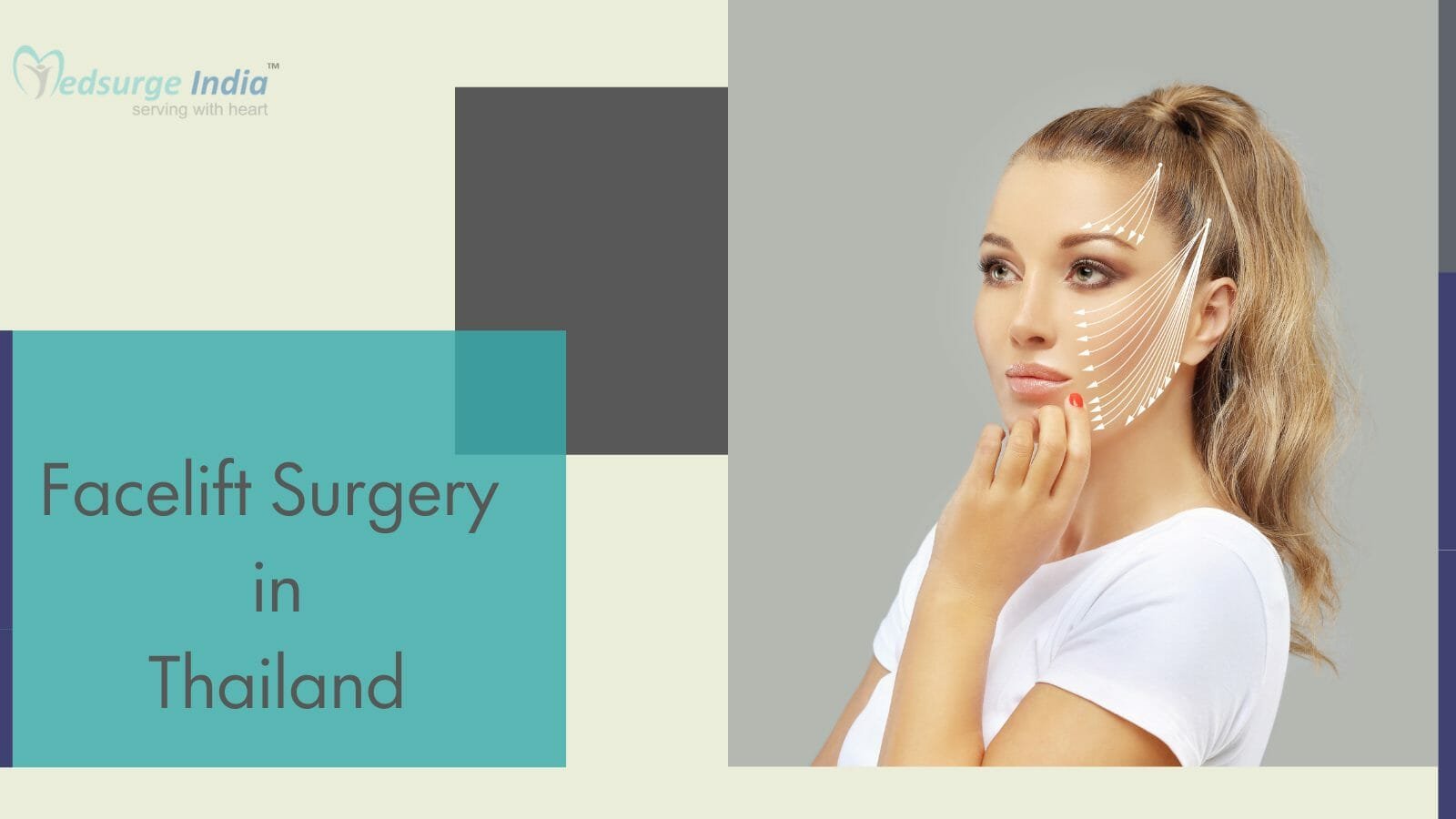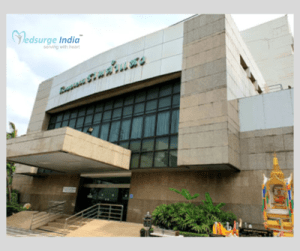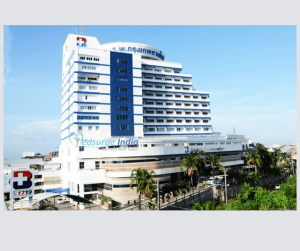Facelift Surgery Cost In Thailand
Unlock Exclusive Discount : Your Gateway to Premium Healthcare with Medsurge India Health Value Card.

Unlock Exclusive Discount : Your Gateway to Premium Healthcare with Medsurge India Health Value Card.


A face-lift, also known as rhytidectomy, is a cosmetic surgery that makes a person’s face look younger. The goal of facelift surgery in Thailand is to minimize the alterations that occur as a result of aging. This involves drooping or folds in the skin, particularly on the cheeks and jawline, as well as other alterations to the face’s contour. Excess skin is removed, and the skin is tightened and smoothed over during a face-lift treatment. It is a cosmetic technique that improves the appearance of the face. A flap of skin is peeled back from both sides of the face during the surgery. The surgeon then works on the face’s contour by altering the tissues beneath the skin.
Medical tourism is a growing industry that the Thai government is actively promoting. Thailand’s high-quality facilities, English-speaking medical staff, cost-effectiveness, and stunning beaches make it one of the most popular vacation destinations.
Thailand’s cosmetic surgeons are well-known for their dedication and expertise. For all types of cosmetic operations, the majority of Thai hospitals provide international facilities with cutting-edge diagnostic methods and innovative technology.
Rhytidectomy, commonly known as a facelift, is a Cosmetic Surgery in Thailand that removes extra skin and tightens facial tissues to give the face a youthful appearance. Sagging and wrinkles occur as the skin and tissues beneath it lose their natural elasticity with aging.
Facelift surgery seeks to tighten the facial tissue as well as smooth out the folds and wrinkles on the skin of the face. To attain a full impact, a person may choose to undergo a brow or eye lift at the same time as a facelift. The surgeon focuses on the lower two-thirds of the face, as well as the upper area of the neck, during facelift surgery in Thailand.
People from all over the world travel to Thailand, one of the most popular medical travel destinations, for low-cost, high-quality treatments. In Thailand, facelift surgery is a safe and effective cosmetic technique with a high success rate. Several plastic surgery clinics and hospitals across the country provide this operation. These medical centers are known for their high-quality services and world-class infrastructure.
National and international accreditation authorities such as Joint Commission International (JCI) and others have accredited Thailand’s best facelift hospitals. These hospitals employ highly qualified and talented surgeons who have years of expertise conducting such treatments.
There is no waiting time, and the surgery can begin as soon as the doctor has completed all of the necessary tests and determined that the patient is a good candidate for the treatment. Patients from all over the world choose to have a lower facelift in Thailand. The foreign patient program of the hospital ensures that patients from other countries receive comprehensive and dependable care.
The average Facelift Surgery Cost in Thailand starts from USD 13000. Facelift Surgery cost in Thailand vary depending on a variety of factors, including the facility, the surgeon’s charge, the complexity of the treatment, and the patient’s health state.
| Cities | Starting Price |
| Bangkok | USD 13,000 |
| Phuket | USD 13,100 |
| Chiang Mai | USD 13,000 |
Please note that the cost may vary based on the patient’s health and the centers.
The standard and excellence of medical treatment and amenities are comparable to those of the most prominent healthcare facilities in the world, even after deducting the cost of lodging, meals, and transportation. Here are some variables that can affect Facelift Surgery cost in Thailand:
Under the direction of the most skilled physicians, Medsurge India provides the most economical Facelift Surgery cost in Thailand for foreign patients.
A good candidate for facelift surgery has the following characteristics:
The most common reason for a facelift is to restore the young aspect of the face and conceal the indications of aging. The following are some of the changes in the face that can be decreased with face-lift surgery:
A face-lift cannot be utilized to treat many types of facial alterations, including superficial wrinkles, creases around the nose and upper lip, sun damage, and uneven skin tone.
Depending on the treatment, there are variations in the facelift surgery process. Hospitalization is not necessary because this surgery is performed as an outpatient. For the procedure, either sedation or general anesthesia is employed. The process takes 2 to 5 hours to complete.
First and foremost, an anesthesiologist administers a specific form of anesthetic. Then, in front of the ear, a plastic surgeon makes an incision that extends to the hairline. If a chin reduction is planned, a doctor will also create an incision beneath it.
A plastic surgeon separates the skin from the other tissues after all incisions have been performed. The skin is then raised and the excess removed using specific equipment.
A surgeon fixes and elevates tissues and muscles once all manipulations are completed, and all punctures are patched up with absorbable sutures. In the last, special bandages are applied.
Modern facelift procedures are risk-free and have few side effects. In the case of a surgical facelift, however, the surgery is not indicated for persons who have:
The following conditions may be added to the list of relative contraindications:
If you have any of these conditions or other health disorders, inform your doctor to discuss the possibility of facelift surgery in your case.
Scars remain after a facelift procedure. They are, however, almost imperceptible. In order to conceal the traces, a doctor makes incisions in the hairy area. A plastic surgeon's expertise is also important: experienced practitioners in Thailand manipulate very precisely, resulting in scars that are little and almost undetectable.
You can do a facelift as many times as you need. Note that the result of a facelift lasts about 7-12 years.
A: After 2–4 weeks, you should look and feel normal. Keep in mind that facelift surgery cannot prevent natural aging, so patients should continue to look after their skin and live a healthy lifestyle. Read on for our suggestions for accelerating your recuperation.
A: A facelift is most effective for persons in their 40s, 50s, and 60s when indications of aging begin to appear. Deep lines, wrinkles, fine lines, and sagging skin are all signs of aging and are best treated with surgery rather than non-surgical procedures.
A: A face-lift, like any other major surgery, carries the risk of bleeding, infection, and an allergic reaction to anesthesia. Complications can also be exacerbated by certain medical problems or lifestyle behaviors.
A: Facelift failures are most likely to occur when a surgeon has the necessary expertise and experience to perform the treatment properly. This is why, for any facial surgery, you should seek out a facial plastic surgeon rather than a general plastic surgeon.
A: Your facial skin may appear tight at first due to postoperative swelling, but this tightness will lessen as the swelling goes down. A professional plastic surgeon should not pull the skin so tight that it appears stretched or feels tight for an extended period of time.






Consultant
53 Years
Bumrungrad International Hospital, Bangkok
View Doctor

Consultant
53 Years
Bumrungrad International Hospital, Bangkok
View Doctor











By using our site, you agree to our Terms and Conditions, Privacy Policy and Refund Policy. Medsurgeindia does not provide medical advice, diagnosis, or treatment. The information provided on this site is designed to support, not replace, the relationship that exists between a patient/site visitor and his/her existing physician. We also Accept International Payments.

Copyright © 2025 NSM ONLINE SOLUTIONS PRIVATE LIMITED. All rights reserved.